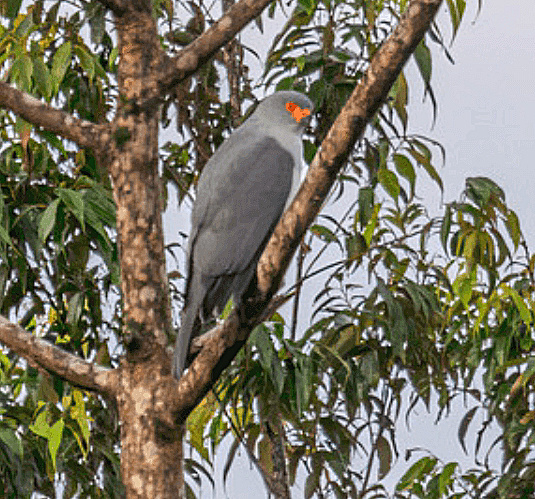
The first photograph taken of the rare New Britain Goshawk documented the bird for the first time in 55 years (photo by Tom Vierus).
|
The rare New Britain Goshawk has been photographed for the first time, and documented for the first time in 55 years! An especially rare bird of prey that is found only on the island of New Britain off the east coast of Papua New Guinea was found in the remarkably biodiverse expanse of tropical forests along the Nakanai Range within the island that measures 323 miles long and 90 miles wide. It is interesting to note that the photographer was not aware of the significance of his photo documentation of the New Britain Goshawk at the time.
“I was on a scouting trip with World Wildlife Fund (WWF) in Pomio (eastern New Britain), with 3 members of the local community who were guiding us through the forest, so we could better understand the presence of species in the area. I photographed several bird species, including the New Britain Goshawk, but wasn't aware of the significance at the time,” said Fiji-based photographer Tom Vierus as he shared how he secured the first photograph.
Confirming the photographed bird was a New Britain Goshawk, John Mittermeier, Director of the Search for Lost Birds at the American Bird Conservancy (ABC) said: “The last documented scientific record of the species appears to be a July 1969 specimen that is kept in the American Museum of Natural History in New York. While there have been multiple sight-only records in the intervening years, the New Britain Goshawk seems to have eluded photo, sound, and specimen documentation for 55 years.”
Oscar Pileng, who was born in Pomio and is WWF’s Pomio-based officer, said: “I have discussed this discovery with local residents and leaders in the area where the New Britain Goshawk was photographed. They shared that this species is definitely rare in Pomio. Some confirmed that this species is not found in coastal areas, but only in the hinterlands of Pomio, and is rarely seen. In local languages the New Britain Goshawk is called Keango or Kulingapa.”
“I was amazed to hear that this is the first time this goshawk has been photographed, but am very happy that an official global record now exists. I hope this means more efforts are made to protect its habitat from the threats of large-scale agriculture, logging, mining, and infrastructure development,” added Pileng.
With the invitation of local communities and government representatives, World Wildlife Fund is trying to add to conservation efforts in Papua New Guinea by expanding its work to Pomio. There, the Indigenous Mengen and Mamusi people maintain largely intact traditions and beliefs intrinsically linked to the forests, rivers, and ocean they have called home for millennia. Working closely with these matrilineal clan-based societies, WWF hopes to support local stewardship to safeguard the future of the incredible biodiversity hotspots through community-led conservation.
“There have been very few biodiversity studies in New Britain, and the potential for discovering species new to science is quite high. But it is a race to protect them, with development pressures looming large and poverty a reality for many people,” said Martha Eimba, Pomio Landscape Manager, WWF-Papua New Guinea. “WWF has begun a process of collaboration to understand the conservation threats, livelihood opportunities, and social contexts, so we can collectively develop a comprehensive conservation program. We are actively seeking partners to help progress this important work.”
Papua New Guinea hosts the third-largest intact tropical forest in the world, following the Amazon and Congo basins. With more than 5,000 lakes, extensive river systems and wetlands, more than 5,000 miles of mangrove swamps, lagoons, coral reefs, and atolls, the nation is remarkably diverse in species, landscapes, ecosystems – and people.
“It was such a great surprise to hear that this photo seems to be the first-ever of this ‘lost species!’ It is wonderful to see how conservation photography can help in safeguarding areas by documenting the existing biodiversity, and it’s also a good reminder of how important visual storytelling is. I truly hope this mostly pristine part of the world can remain as intact as possible with the help of the local communities, their already existing conservation initiatives, and the support of WWF,” added Vierus.
You can refer to the original article published online by the American Bird Conservancy at Lost Bird for 55 Years: Rare Goshawk Photographed for First Time in Papua New Guinea - American Bird Conservancy (abcbirds.org)